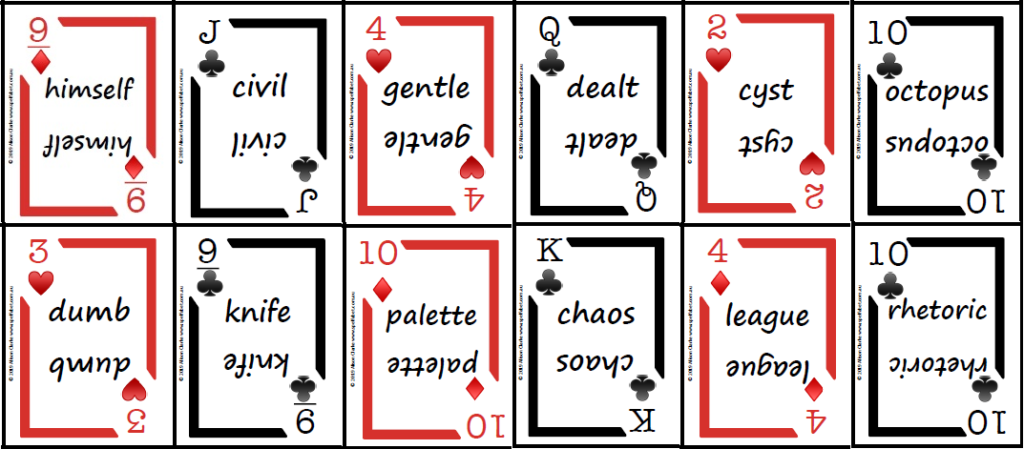Half-price phonics playing cards, for social, screen-free fun
0 Replies
Before we had Netflix or even TV, families and friends had lots of fun together playing cards. Playing cards were invented in China over a thousand years ago, and spread via Persia and the Middle East to Europe by about 1400 (learn about their fascinating history here).
A standard deck of playing cards can be used to play hundreds of different games, involving matching, trick-taking, shedding, catching/collecting, fishing, comparing, and much more. From Snap to Poker, there’s something for every age and ability level.
Card games can be used for high-repetition phonics practice by putting words containing a student’s phonics targets on the cards, and requiring each card’s word to be read when it is played. I like to play a game, ask the student(s) to spell a few of the words on the cards, and then have another game. This reinforces the idea that reading and spelling are reciprocal processes.
If you don’t have favourite childhood card games you can teach kids, we have some videos of how to play games we like, and there are heaps more here, or just put “playing card games for kids” into a search engine to find a cornucopia of games.
12 new phonics playing card decks
We’ve just put a new set of downloadable phonics playing cards in the Spelfabet shop, These decks fill some gaps in our previous decks – compound words, “soft” C and G, additional spellings of “short” vowel sounds – and then present additional consonant sounds with multiple spellings. Here’s what one card from each deck looks like:

All our playing cards are half price till 13 September, the earliest date Melbourne’s COVID-19 Stage 4 lockdown will be lifted (fingers crossed, 179 new cases yesterday). Lots of us need fun things to do till then.
The cards are child-sized (5 X 6.5cm), with words facing in two directions, so they’re easy to read from either side of a table. Their sequence broadly matches the Sounds-Write/Dandelion/Phonic Books/Forward With Phonics teaching sequence, but if you use a different phonics teaching sequence, you can reorganise them.
Playing Cards Index page
There are now 81 decks of phonics playing cards in the Spelfabet shop (14 are free). It’s hard to scan through them all, so we now have a Playing Cards index page linked to the main menu, to help you find the deck(s) you want and get the best value for money.
The page is organised in groups based on how hard the words are, apart from the last group, which is a bit of a mixture. For each group, only two decks are showing until you change the “Show 2 entries” drop-down menu to say “Show 25 entries”, to make all the decks (between 12 and 18 of them) visible.

Download, print and cut up your cards, and enjoy!
These playing cards are downloadable files (that’s why they’re free/so cheap), so it’s your job to colour-print them on light cardboard (packs of 200gsm A4 cardboard are available at major stationers, some of whom will print them on card for you), laminate them if you plan to use them a lot, and cut them up, perhaps while watching Netflix/TV, or get the kids to do it. If any get lost or wrecked, you can just print more.
Thanks as always to the fabulous Spelfabet team for their work on these, especially Caitlin Stephenson for the original idea, Renee Vlahos for layout/formatting, laminating and lots of patient cutting-up, and Tessa Weadman for game video appearances, and lately for cheering us up with her new puppy at Zlunch.



Leave a Reply